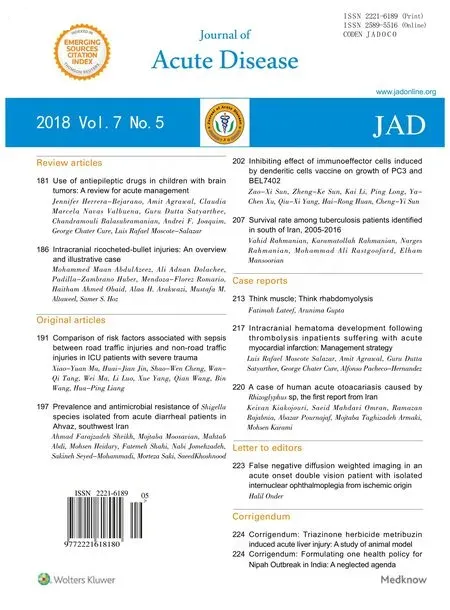False negative diffusion weighted imaging in an acute onset double vision patient with isolated internuclear ophthalmoplegia from ischemic origin
Halil Onder
Neurology Clinic, Yozgat City Hospital, Yozgat, Turkey
Keywords:Internuclear ophthalmoplegia Stroke False-negative-stroke
Dear Editor,
A-72-year-old male with medical history of hypertension admitted with acute onset double vision. On neurological examination, right eye could not adduct whereas nystagmus occurs on the left eye abduction. Cranial diffusion weighted imaging (DWI) was in normal ranges. Based on the negative DWI result and atypical clinical presentation for stroke, third nerve paly was considered in the forefront and the patient was planned to be discharged with suggestion of ophthalmology outpatient visit. However, following neurology evaluation, the diagnosis of left internuclear ophthalmoplegia (INO) was favored.Other neurological examinations including motor, sensory and cerebellar investigations were in normal ranges. On etiological aspect, a provisional diagnosis of ischemic stroke with negative DWI was considered and the patient was hospitalized after initiation of aspirin and enoxaparin therapies. Repeated DWI also resulted in normal findings. Finally, additional thin section axial DWI (performed on the fourth day of the clinical onset)showed restricted diffusion in the inferior midbrain, just anterior to the cerebral aqueduct (Figure 1). Further investigations for stroke etiology, including brain/neck tomography angiography,echocardiography, electrocardiography, were in normal ranges. 24-hour-Holter monitoring revealed PAF attacks. With the diagnosis of cardioembolic stroke, dabigatran 2×110 mg and metoprolol 50 mg treatments were initiated.
INO is a deficit in the control of conjugate eye movements, which results from damage to the medial longitudinal fasciculus at the brainstem that connects with ocular nuclei of 6th and 3th nerves[1].Stroke is one of the most common pathophysiologic group of this manifestation[2]. However, pure isolated ischemic stroke from ischemic origin has rarely been reported in literature[1,3]. Clinical awareness of this syndrome is vital for the diagnosis such that in a crucial study, it was reported that MRI could demonstrate ischemic lesions producing INO in only 52% of the patients[2].Of note, in this study, all manifestations including INO from ischemic origin were included and not a method of selection of the isolated INO patients was conducted. Therefore, considering that lesion resulting in solely INO (without accompanying other manifestations) would rather concern a localized region and negative DWI can be seen rather in small ischemic lesions[4], I think that false negative DWI results would be higher than this ratio (52%) in patients with isolated INO presentations. Taken together, the presentation of this rare case with INO at whom initial DWIs failed to show ischemic lesion (2 times) constitutes a remarkable sample in this regard.

Figure 1. DWI result.
In the largest report in literature, the etiological classification of stroke origin in INO clinics was reported to be varying, ranging from small-vessel occlusion, branch atheromatous disease of PCA,SCA, or severe proximal BA stenosis or occlusion[1]. However, the stroke etiology in our patient was determined as cardioembolic,expanding the underlying pathogenesis in this syndrome.
In conclusion, herein, I present a rare patient with false negative DWI at whom clinical presentation constituted a strictly challenging issue in the emergency department. Based on this rare illustration, first, I draw attention to the importance of multimodal evaluation of the patients with stroke pre-diagnosis and avoid MRI based evaluation as DWI may be insufficient to detect ischemic lesion in early phase, particularly in the posterior circulation and minor stroke syndromes[4]. In addition, I point out this rare manifestation of isolated INO due to ischemic stroke which should be kept in mind among emergency practice for avoiding underdiagnosis. This case may also give crucial perspectives pointing out the importance of repeating DWIs in stroke like clinics with negative initial DWI results. I particularly suggest to repeat DWI,even multiple times, as negative DWI results is not rare in this rare manifestation of INO from ischemic origin[2].
Conflict of interest statement
The authors declare that there is no conflict.
 Journal of Acute Disease2018年5期
Journal of Acute Disease2018年5期
- Journal of Acute Disease的其它文章
- CORRIGENDUM
- A case of human acute otoacariasis caused by Rhizoglyphus sp, the first report from Iran
- Intracranial hematoma development following thrombolysis inpatients suffering with acute myocardial infarction: Management strategy
- Think muscle; Think rhabdomyolysis
- Survival rate among tuberculosis patients identified in south of Iran,2005-2016
- Inhibiting effect of immunoeffector cells induced by denderitic cells vaccine on growth of PC3 and BEL7402
